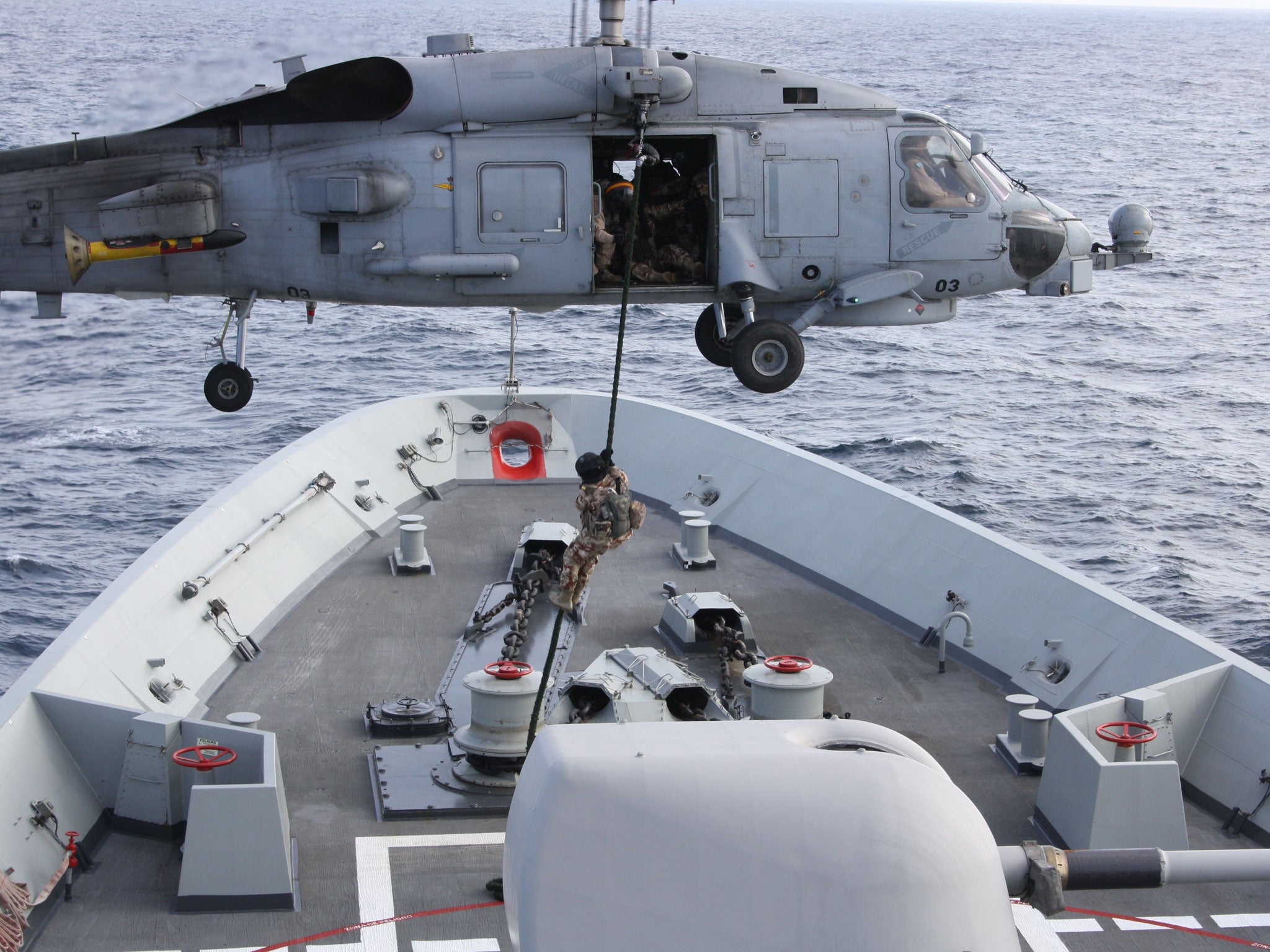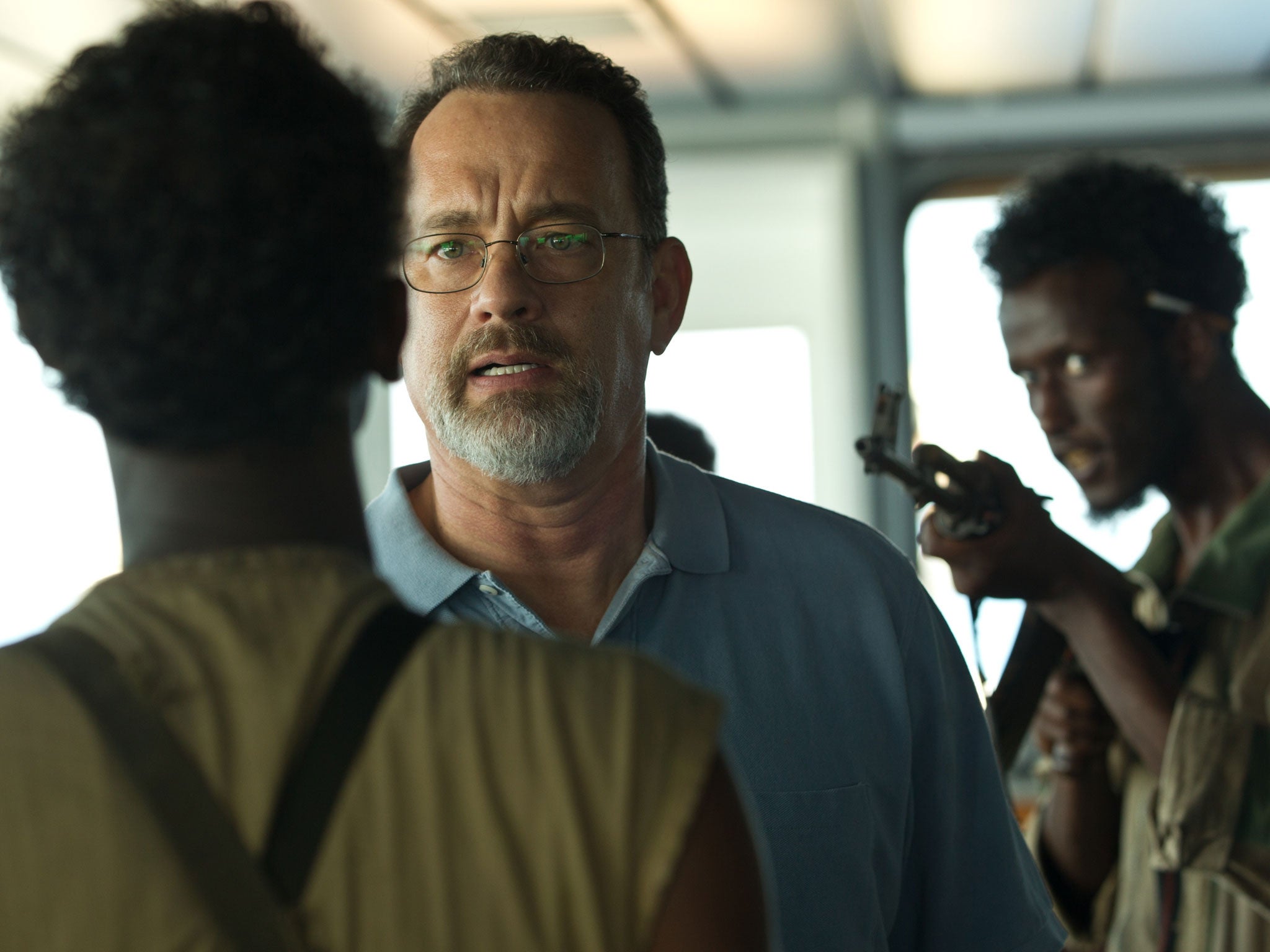Battle of the high seas: On patrol with NATO's pirate-catchers off the Horn of Africa
Infra-red cameras, ballistic missiles... the battle of the high seas is increasingly one-sided

Your support helps us to tell the story
From reproductive rights to climate change to Big Tech, The Independent is on the ground when the story is developing. Whether it's investigating the financials of Elon Musk's pro-Trump PAC or producing our latest documentary, 'The A Word', which shines a light on the American women fighting for reproductive rights, we know how important it is to parse out the facts from the messaging.
At such a critical moment in US history, we need reporters on the ground. Your donation allows us to keep sending journalists to speak to both sides of the story.
The Independent is trusted by Americans across the entire political spectrum. And unlike many other quality news outlets, we choose not to lock Americans out of our reporting and analysis with paywalls. We believe quality journalism should be available to everyone, paid for by those who can afford it.
Your support makes all the difference.The Somali pirate drama is over in seconds: a helicopter swoops into view and hovers over the hijacked vessel, four hooded marines slide down ropes, the hostiles are overpowered, and the ship’s hostages released. Or at least, that is what NATO is rehearsing as it polices the world's busiest shipping lane and its most dangerous waters, the sea around the Horn of Africa.
This particular drill takes place on the deck of the Álvaro de Bazán, a 5,800-tonne, 147-metre Spanish frigate patrolling the Red Sea, while the pirates are merely other crew on the vessel. But such exercises are repeated almost daily to keep the crew sharp for actual encounters with the pirates who still threaten the trillion-dollar shipping that passes near the Somali coast.
“We prepare as much as we can for any situation in these waters,” says Paul Meacher, a 35-year-old lieutenant commander from Hampshire. “Fighting piracy is maritime security, not shock and awe warfare, so you have to adapt and use different techniques to deal with the challenge. It’s low intensity, but still high risk.”
Meacher is the only British member of the Álvaro de Bazán’s 250-strong crew, acting as the staff operations officer for the NATO anti-piracy fleet. Like almost everyone else on board, he refers to Captain Phillips, last year’s Tom Hanks movie about how the freighter Maersk Alabama was hijacked by four ragtag Somalis in 2009.

Patrols by around 14 vessels from NATO, the European Union and other countries have helped drive down piracy since then, but there are still attacks nearly every week in the area. “We don’t take anything for granted,” says Meacher. “It’s a bit like being a policemen: just because crime has fallen doesn’t mean you stop going on the beat.”
Some 90 per cent of all global trade by volume is shipped by sea, and about half of that passes through the Indian Ocean, including one-third of Europe's oil supplies. More than 22,000 cargo ships travel through the choke point at Bab-el-Mandeb, the so-called Gate of Grief, the strait between Yemen and Djibouti that links the Red Sea and the Suez Canal to the Gulf of Aden and the Indian Ocean. But the NATO forces operate from the Persian Gulf to the Seychelles in the south and the Maldives in the east, covering an area greater than 2 million square miles or the size of Western Europe. And they are acutely aware of overstretch.
But this is the sort of challenge that NATO is increasingly addressing. NATO Secretary General Anders Fogh Rasmussen argues that as the alliance shifts gears in the post-Afghanistan era, it is dealing with non-state threats like thwarting desperadoes in speedboats.
So NATO’s counter piracy task force is now using new methods to find the pirate scourge: the patrols use a variety of measures to verify the activity of shipping off the coast of Somalia, separating out legitimate maritime traffic from suspected pirate vessels, and in many cases escorting ships through the most tricky passages.
There is an array of dazzling technologies at the task force’s disposal, from stealth technology to avoid enemy radar, ballistic missiles that could sink an aircraft carrier, sniper rifles that have an effective range of three miles, and infrared cameras that can see figures from seven miles away. They also have AWACS surveillance planes, use Mercury, a secure internet-based communication system set up by the British, while unmanned drones are used to spot pirate camps.
Álvaro de Bazán, the flagship of NATO’s anti-piracy mission, can send teams to pre-emptively board a suspect vessel, and even use force to stop them. The task force commander, Rear-Admiral Eugenio Diaz De Rio, based on the Álvaro de Bazán, echoes the mantra that counter-piracy is now to be part of NATO’s portfolio of activities. “We need to do this to protect our trade,” he says. ”And we have faced tough challenges, including coordination with non-NATO vessels as well as the huge area of operations we have to police.”
Other factors have helped curb piracy. The spread of ‘best management practices’, has given simple but often crucial advice for captains sailing at-risk areas, like maintaining high cruising speeds (pirates have never successfully taken a ship traveling faster than 18 knots), building citadels to protect the crew and fitting razor wire along a ship’s side. Private armed security guards are another cause, with shipping companies overcoming their qualms that they would escalate violence. They have proved a powerful deterrent and not a single vessel with guards - mostly British former Royal Marines - has been boarded.
But it is the presence of the NATO fleet – bolstered by the flotillas from the EU and other navies – that has been most imposing. “It shows that increasingly, NATO isn't asked to take on conventional military challenges but will have to develop new capabilities, partnerships, doctrine, and strategy for coping with difficult asymmetric challenges,” says Julianne Smith, a fellow at Chatham House. “And despite declining defense budgets, NATO can successfully adapt to the security challenges of the 21st century.”
There are still many would-be pirates. They are often teenagers in flip-flops, but they use satellite phones and GPS to communicate, and are also heavily armed with rocket-propelled grenades and AK-47s. Their speedboats, or skiffs, approach the vessels and with grappling hooks and irons - some of which are even rocket-propelled - they climb aboard using ropes and ladders. The pirates treat the ship, its cargo and its crew as hostages and hold them for ransom for anything up to $7 million – a fortune in Somalia where there are no jobs and almost half the population needs food aid after 17 years of non-stop conflict.
And the pirates have adapted to the naval presence. Now that high-value ships sail much farther from the coast, the pirates have learnt to roam farther by using ‘mother ships’ - powerful deep-sea fishing vessels seized earlier - as floating bases for their speed boats or skiffs. The mother ships allow the pirates to stay at sea for more than a month at a time. While the average distance for an attack in 2005 was 109km away from the coast, by 2012 this figure had risen to 746km. They are also still holding more than 70 sailors hostage.
This is why everyone in the anti-piracy effort is cautious about recent figures from International Maritime Bureau (IMB), a body that fights shipping crime, showing that piracy at sea is at its lowest level in six years. The IMB says there were only 15 declared incidents off Somalia last year – around 19 per cent of all attacks worldwide - down from 75 in 2012, and 237 in 2011. But Pottengal Mukundan, IMB's director warns that the pirates are biding their time. “Pirates continue to operate and the situation off the Horn of Africa can quickly change,” he says. “But actions such as aerial surveillance, the interdiction and disarming of pirate vessels and the detention of suspected pirates can only be done by the naval vessels.”
There is also consensus that the seas will need policing as long as the underlying causes of piracy remain. Somalia is still a failed state, a chaotic, impoverished, lawless land that is chronically insecure and now increasingly prey to Islamic terrorism (the Westgate Mall attack in Nairobi last year was the work of Somalia-based Islamist militant group al-Shabab).
On the Álvaro de Bazán, Paul Meacher reels off the ships many smart counter-piracy activities, but admits that a long-term solution will have to involve reconstruction in Somalia, including building up a functioning government with coastguards, courts and prisons. That is beyond NATO’s remit, so for the moment the fleet in the Red Sea still patrolling its beat. “The threat of piracy remains, and we can’t leave our guard down,” Meacher says. “But we have shown we have what it takes to adapt to new missions in theatres far from home.”
Join our commenting forum
Join thought-provoking conversations, follow other Independent readers and see their replies
Comments